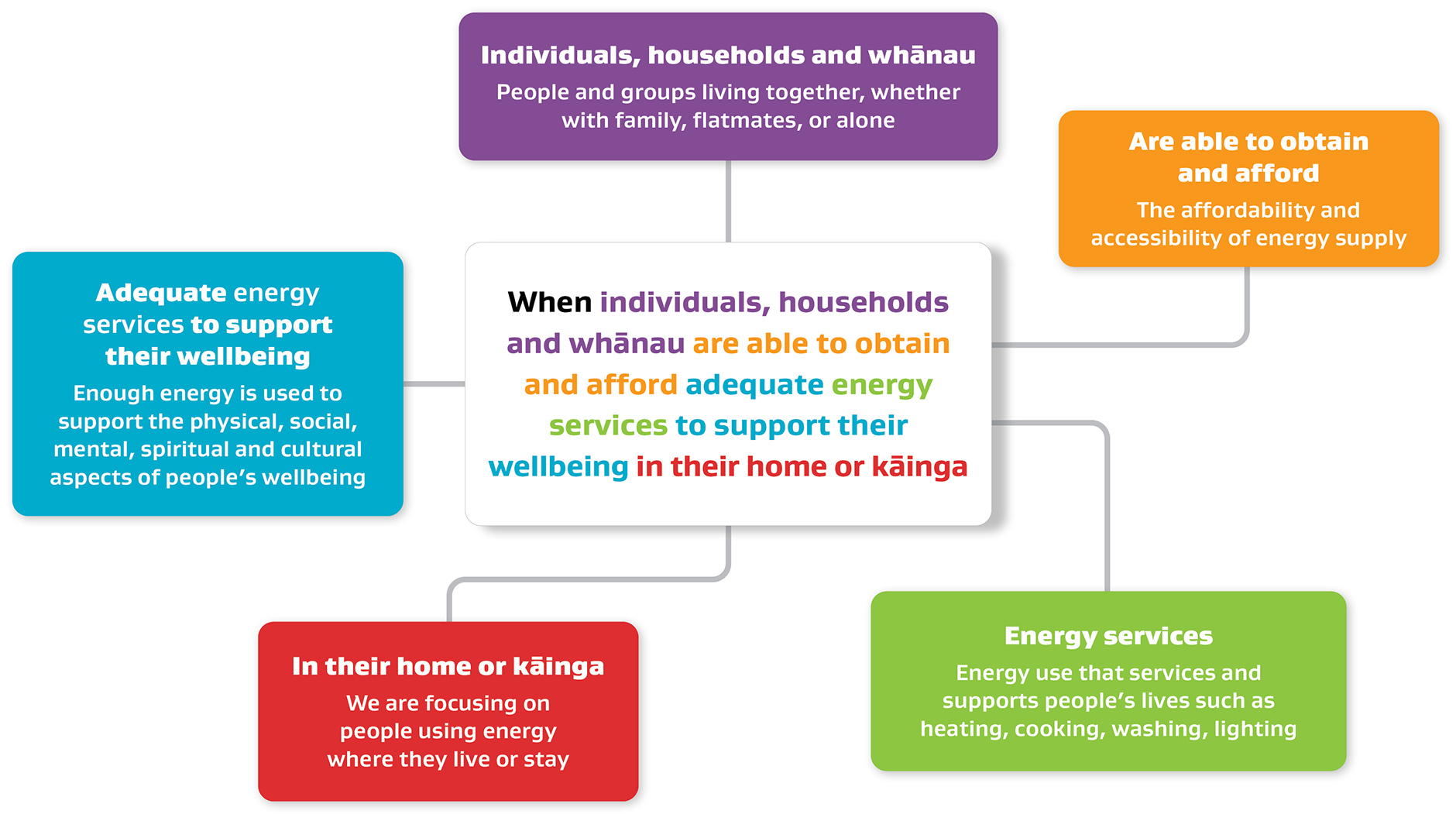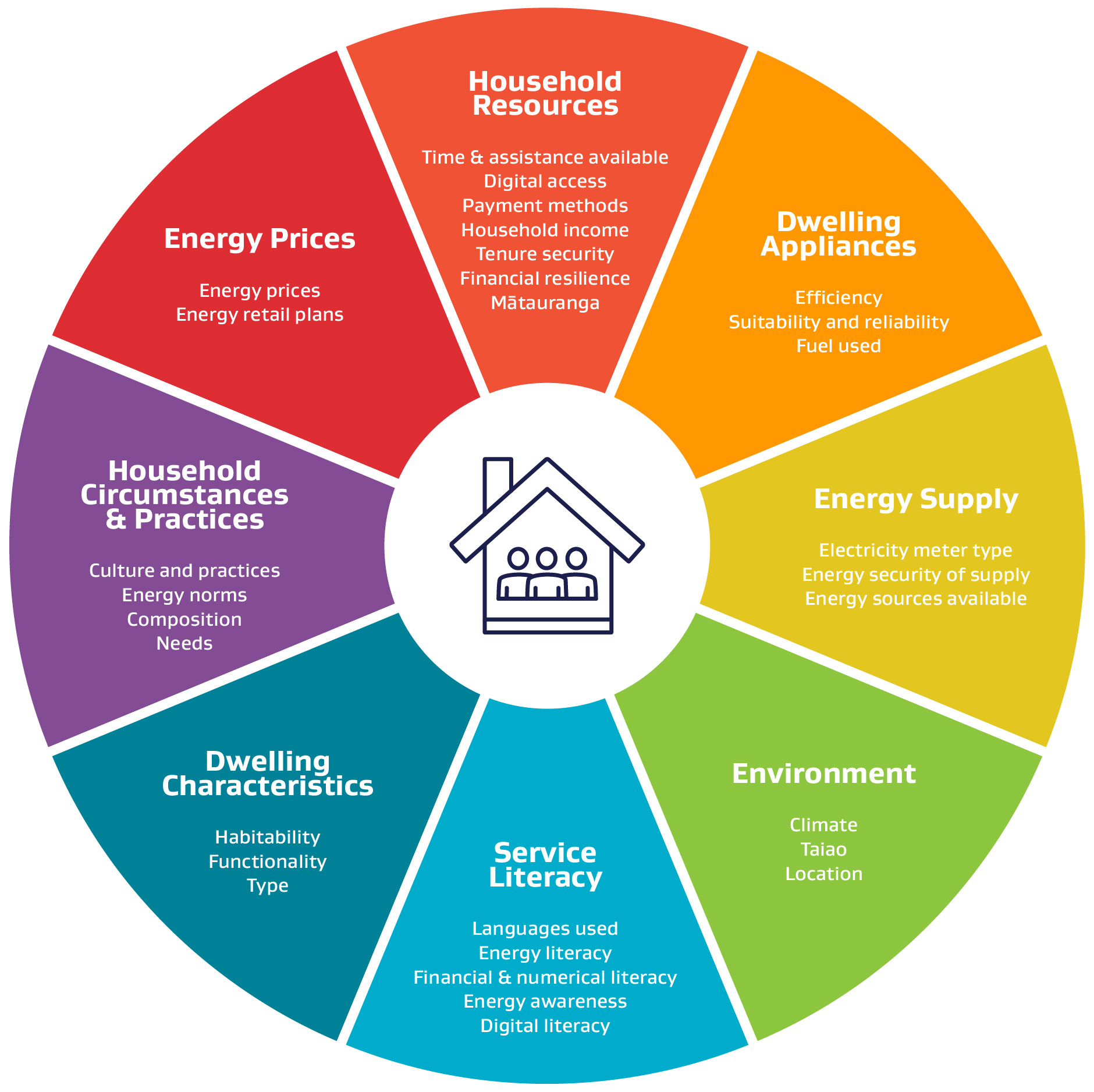Defining energy hardship
The Ministry of Business, Innovation, and Employment (MBIE) has developed a definition of energy hardship and an initial set of measures that will be used to monitor energy hardship over time.
On this page
Background
For some New Zealanders, accessing enough energy in their homes while also staying on top of their bills is a challenge. There are a wide range of factors that can affect the energy situation of households and contribute to them living in energy hardship. Despite this New Zealand has lacked a nationally accepted definition or method of measuring energy hardship.
To develop a definition and conceptual framework of energy wellbeing, MBIE engaged with a range of stakeholders and experts including:
- other government agencies
- the energy industry
- researchers
- Māori interest groups
- community organisations.
MBIE consulted on its proposed definition and suite of measures for energy hardship at the end of 2021. We also ran several public webinars and wānanga with Māori communities, and commissioned a report to capture Māori perspectives on energy wellbeing.
The Discussion Document, summary of submissions and other supporting material are available on the link below.
Have your say: Defining Energy Hardship consultation
This work was one of the recommendations of the Electricity Price Review to government to support efforts aimed at alleviating energy hardship. The Energy Hardship webpage has information on other related initiatives that were developed in response to the Review’s recommendations.
A definition of energy wellbeing for Aotearoa
The Electricity Price Review recommended that MBIE develop a definition of energy hardship. With the government’s focus on promoting the wellbeing of all New Zealanders, MBIE developed a definition of energy wellbeing:
"Energy wellbeing is defined as when individuals, households and whānau are able to obtain and afford adequate energy services to support their wellbeing in their home or kāinga."
Each component of this definition is explained in the coloured boxes in the below illustration.

Energy wellbeing definition and explanation
Energy hardship and energy wellbeing
Energy hardship is the opposite of energy wellbeing. That is, it is the situation when individuals, households and whānau are not able to obtain and afford adequate energy services to support their wellbeing in their home or kāinga.
An energy wellbeing framework
Alongside this definition, MBIE developed a framework of energy wellbeing.
This demonstrates the different factors that can interact and affect energy wellbeing or hardship. It helps identify the underlying drivers of a household’s energy situation, which can then be used to develop or focus initiatives aimed at reducing energy hardship. This framework is shown in the below diagram.

Conceptual framework for energy wellbeing
People and their dwellings are at the centre of the framework, surrounded by the factors that can affect their energy wellbeing. Factors can interact with each other in a number of ways so individual households may have different experiences of energy hardship.
A description of the components of this framework is available in the following document.
This framework may evolve over time as further research, analysis, and engagement is undertaken to deepen our understanding of energy hardship in New Zealand.
Measuring energy hardship
In June 2023, MBIE released an initial set of measures that can be used to understand the level of energy hardship in New Zealand, and amongst various demographic groups, and monitor how it changes over time.
The measures will also be used to help develop or improve initiatives aimed at reducing levels of energy hardship.
Using these measures, MBIE will report annually on energy hardship in New Zealand. The first report, for the period 1 July 2012 to 30 June 2022, is available on the Report on energy hardship measures webpage.
Report on energy hardship measures
Energy hardship measures and what they show
-
Could not pay electricity, gas rates, or water bills on time more than once in the last 12 months:
Households that have been unable to pay bills on time are likely to be at risk of disconnection. -
Cannot afford to keep dwelling adequately warm:
Direct measure of energy hardship as shows energy rationing and the ability of the household to pay for heating. - Put up with feeling cold a lot to keep costs down:
Direct measure of energy hardship as shows energy rationing. -
Dampness and/or mould a major problem:
Indicates poor housing quality and internal environment – such a dwelling is likely to be underheated. Additionally, damp homes require more energy to heat. -
Trouble heating accommodation and or/keeping it warm in winter:
Indicative of quality of dwelling as it is unlikely to be energy efficient and more costly to heat/cool and maintain at a healthy temperature.
This set of measures was finalised following feedback from the 2021 public consultation, further targeted consultation, analysis and research. The measures are based on already existing data collected annually by Stats NZ.
The ‘Energy hardship definition and measures final report’ outlines MBIE’s public consultation and engagement process, summary of the feedback and discussion of key points.
Energy hardship can look very different between households, and as a result, it is difficult to develop a set of measures that captures all experiences.
MBIE is continuing to research how these measures may be strengthened and whether additional measures should be added.
Energy hardship is currently a priority area of the government’s Data Investment Plan. This work will support further engagement with the energy industry, community organisations, Māori, and others to explore how their information can be used to better understand and measure energy hardship.

